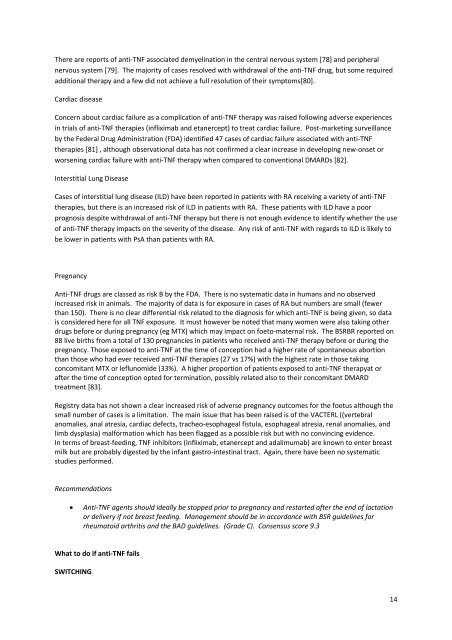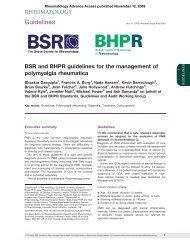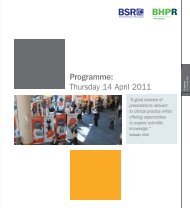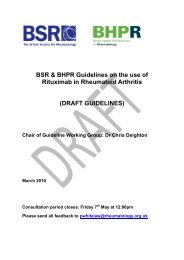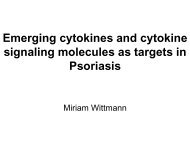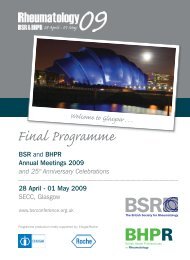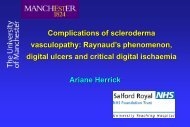Guidelines for the treatment of psoriatic arthritis with biologics
Guidelines for the treatment of psoriatic arthritis with biologics
Guidelines for the treatment of psoriatic arthritis with biologics
Create successful ePaper yourself
Turn your PDF publications into a flip-book with our unique Google optimized e-Paper software.
There are reports <strong>of</strong> anti‐TNF associated demyelination in <strong>the</strong> central nervous system [78] and peripheral<br />
nervous system [79]. The majority <strong>of</strong> cases resolved <strong>with</strong> <strong>with</strong>drawal <strong>of</strong> <strong>the</strong> anti‐TNF drug, but some required<br />
additional <strong>the</strong>rapy and a few did not achieve a full resolution <strong>of</strong> <strong>the</strong>ir symptoms[80].<br />
Cardiac disease<br />
Concern about cardiac failure as a complication <strong>of</strong> anti‐TNF <strong>the</strong>rapy was raised following adverse experiences<br />
in trials <strong>of</strong> anti‐TNF <strong>the</strong>rapies (infliximab and etanercept) to treat cardiac failure. Post‐marketing surveillance<br />
by <strong>the</strong> Federal Drug Administration (FDA) identified 47 cases <strong>of</strong> cardiac failure associated <strong>with</strong> anti‐TNF<br />
<strong>the</strong>rapies [81] , although observational data has not confirmed a clear increase in developing new‐onset or<br />
worsening cardiac failure <strong>with</strong> anti‐TNF <strong>the</strong>rapy when compared to conventional DMARDs [82].<br />
Interstitial Lung Disease<br />
Cases <strong>of</strong> interstitial lung disease (ILD) have been reported in patients <strong>with</strong> RA receiving a variety <strong>of</strong> anti‐TNF<br />
<strong>the</strong>rapies, but <strong>the</strong>re is an increased risk <strong>of</strong> ILD in patients <strong>with</strong> RA. These patients <strong>with</strong> ILD have a poor<br />
prognosis despite <strong>with</strong>drawal <strong>of</strong> anti‐TNF <strong>the</strong>rapy but <strong>the</strong>re is not enough evidence to identify whe<strong>the</strong>r <strong>the</strong> use<br />
<strong>of</strong> anti‐TNF <strong>the</strong>rapy impacts on <strong>the</strong> severity <strong>of</strong> <strong>the</strong> disease. Any risk <strong>of</strong> anti‐TNF <strong>with</strong> regards to ILD is likely to<br />
be lower in patients <strong>with</strong> PsA than patients <strong>with</strong> RA.<br />
Pregnancy<br />
Anti‐TNF drugs are classed as risk B by <strong>the</strong> FDA. There is no systematic data in humans and no observed<br />
increased risk in animals. The majority <strong>of</strong> data is <strong>for</strong> exposure in cases <strong>of</strong> RA but numbers are small (fewer<br />
than 150). There is no clear differential risk related to <strong>the</strong> diagnosis <strong>for</strong> which anti‐TNF is being given, so data<br />
is considered here <strong>for</strong> all TNF exposure. It must however be noted that many women were also taking o<strong>the</strong>r<br />
drugs be<strong>for</strong>e or during pregnancy (eg MTX) which may impact on foeto‐maternal risk. The BSRBR reported on<br />
88 live births from a total <strong>of</strong> 130 pregnancies in patients who received anti‐TNF <strong>the</strong>rapy be<strong>for</strong>e or during <strong>the</strong><br />
pregnancy. Those exposed to anti‐TNF at <strong>the</strong> time <strong>of</strong> conception had a higher rate <strong>of</strong> spontaneous abortion<br />
than those who had ever received anti‐TNF <strong>the</strong>rapies (27 vs 17%) <strong>with</strong> <strong>the</strong> highest rate in those taking<br />
concomitant MTX or leflunomide (33%). A higher proportion <strong>of</strong> patients exposed to anti‐TNF <strong>the</strong>rapyat or<br />
after <strong>the</strong> time <strong>of</strong> conception opted <strong>for</strong> termination, possibly related also to <strong>the</strong>ir concomitant DMARD<br />
<strong>treatment</strong> [83].<br />
Registry data has not shown a clear increased risk <strong>of</strong> adverse pregnancy outcomes <strong>for</strong> <strong>the</strong> foetus although <strong>the</strong><br />
small number <strong>of</strong> cases is a limitation. The main issue that has been raised is <strong>of</strong> <strong>the</strong> VACTERL ((vertebral<br />
anomalies, anal atresia, cardiac defects, tracheo‐esophageal fistula, esophageal atresia, renal anomalies, and<br />
limb dysplasia) mal<strong>for</strong>mation which has been flagged as a possible risk but <strong>with</strong> no convincing evidence.<br />
In terms <strong>of</strong> breast‐feeding, TNF inhibitors (Infliximab, etanercept and adalimumab) are known to enter breast<br />
milk but are probably digested by <strong>the</strong> infant gastro‐intestinal tract. Again, <strong>the</strong>re have been no systematic<br />
studies per<strong>for</strong>med.<br />
Recommendations<br />
• Anti‐TNF agents should ideally be stopped prior to pregnancy and restarted after <strong>the</strong> end <strong>of</strong> lactation<br />
or delivery if not breast feeding. Management should be in accordance <strong>with</strong> BSR guidelines <strong>for</strong><br />
rheumatoid <strong>arthritis</strong> and <strong>the</strong> BAD guidelines. (Grade C). Consensus score 9.3<br />
What to do if anti‐TNF fails<br />
SWITCHING<br />
14


